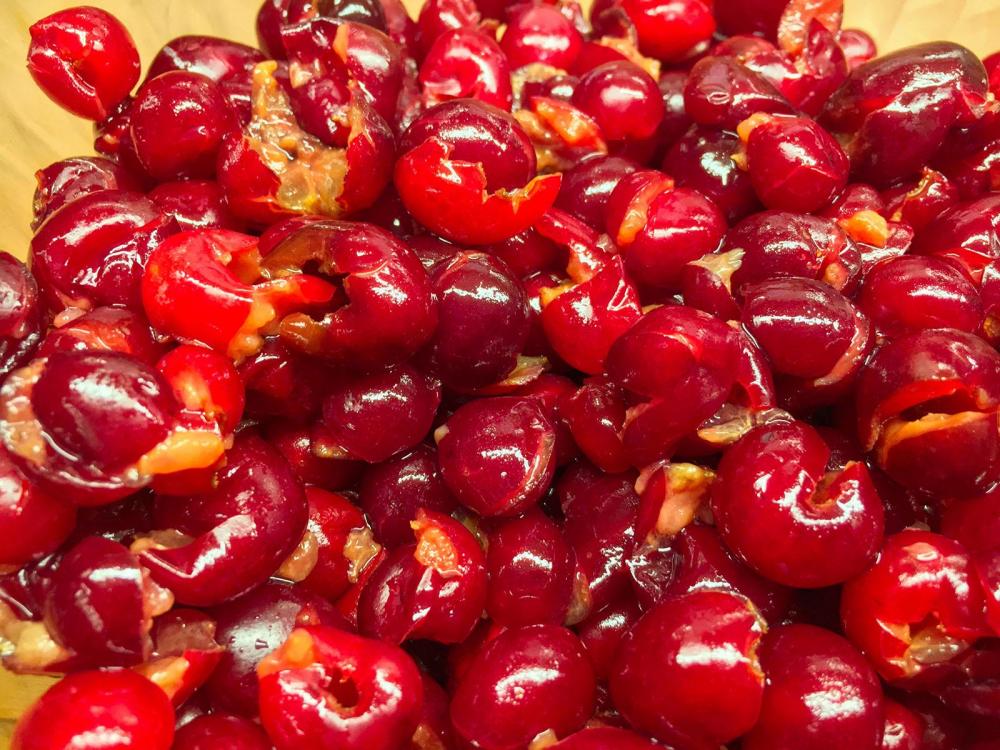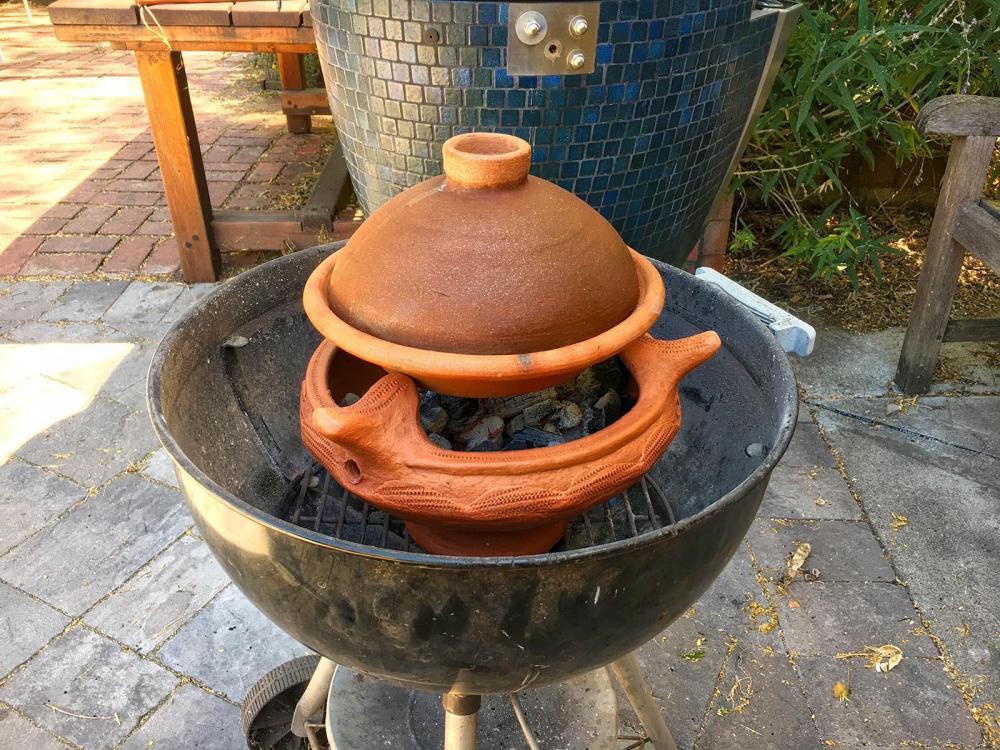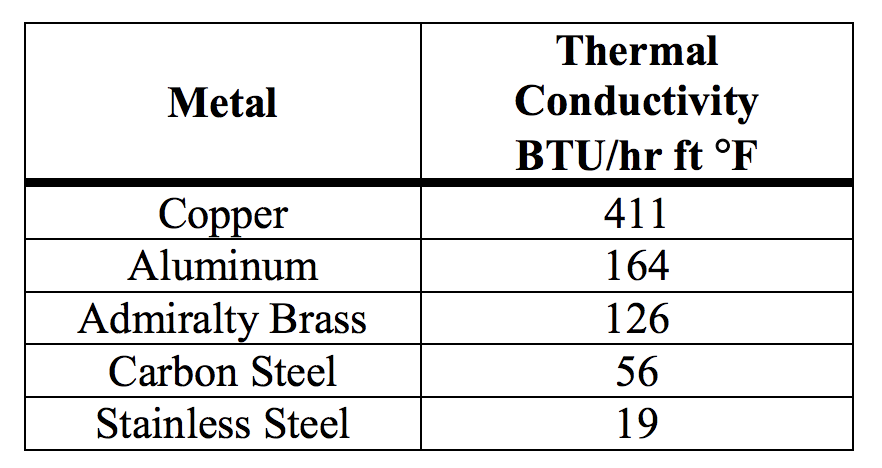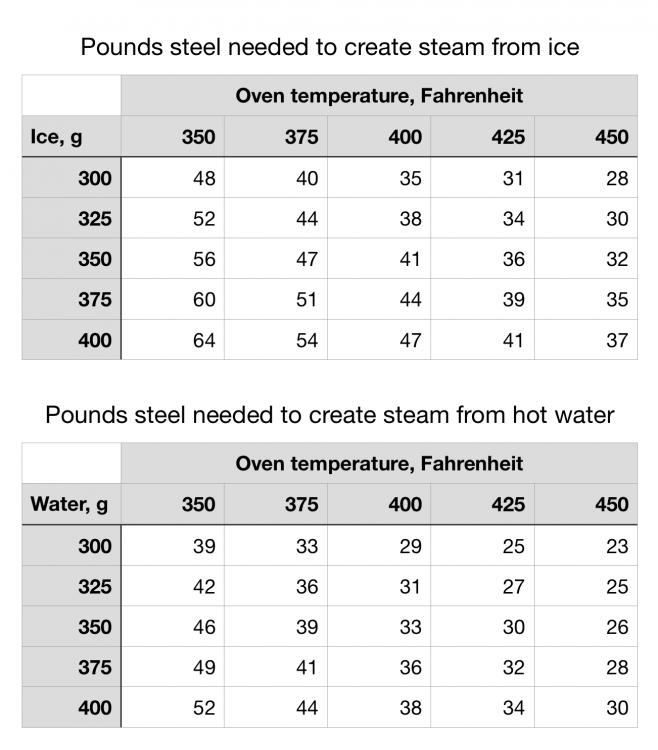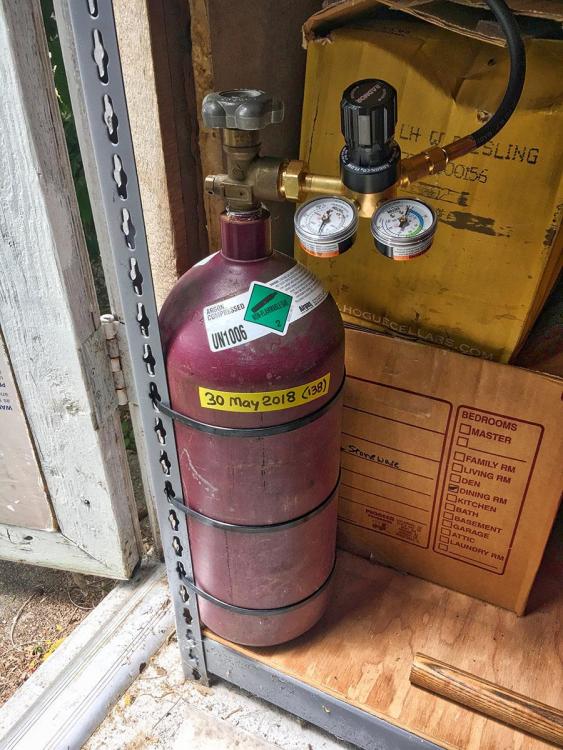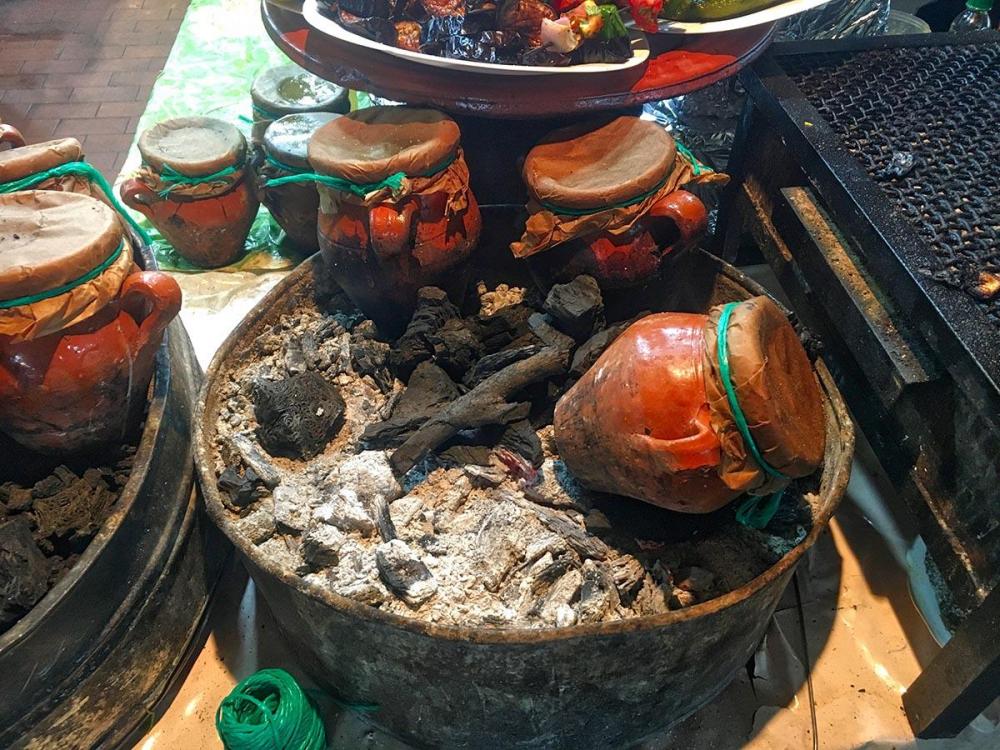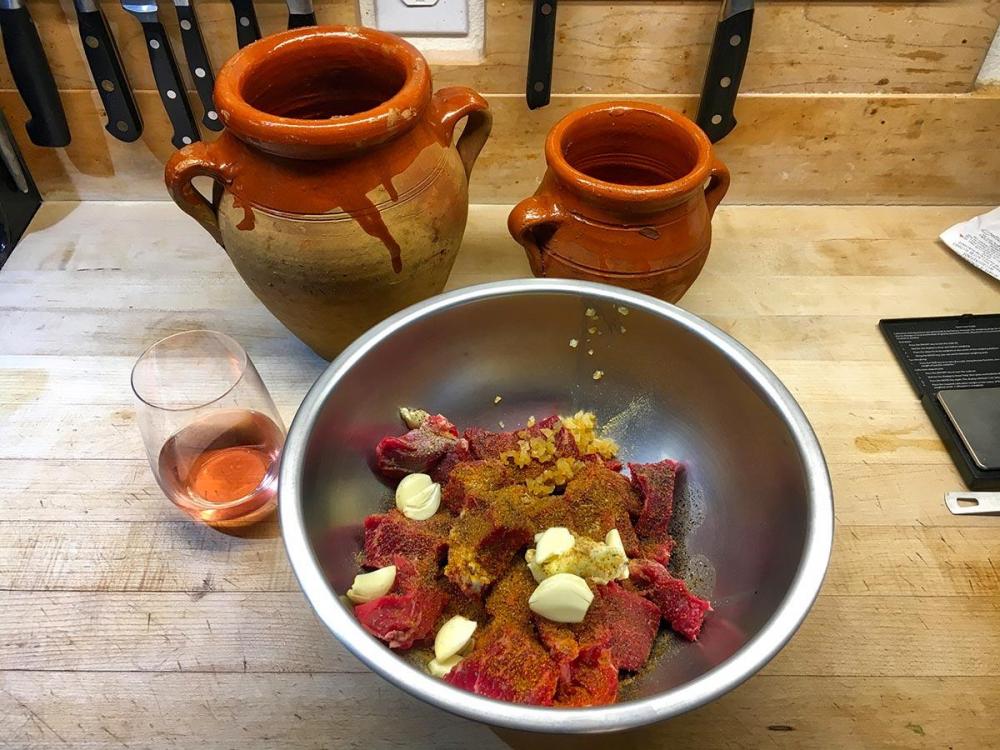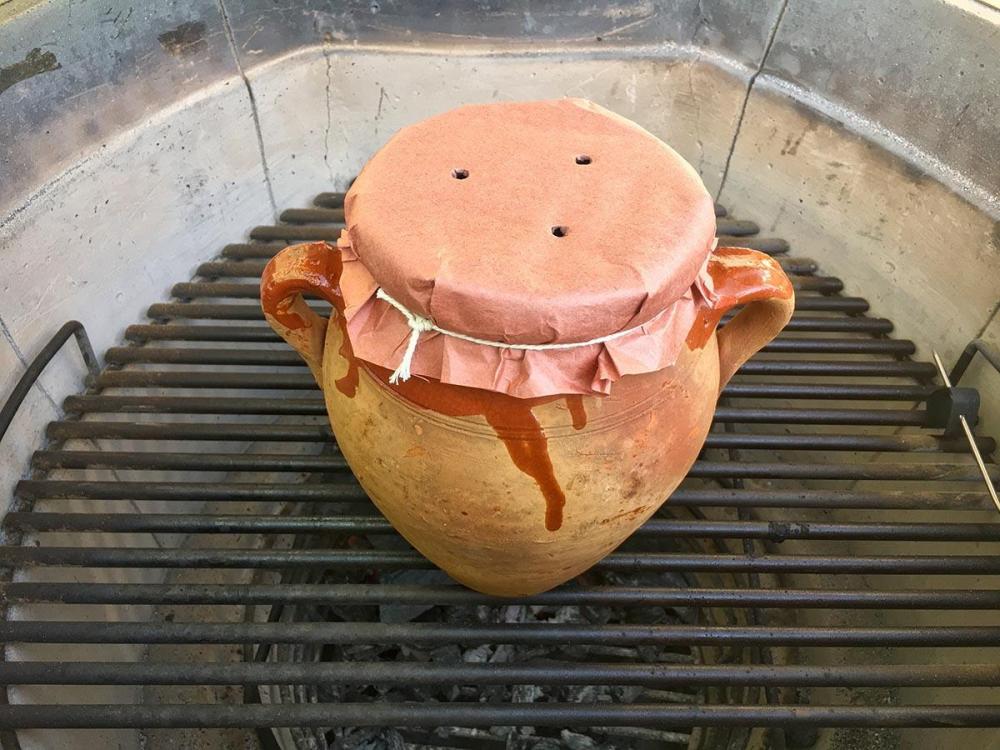-
Posts
1,739 -
Joined
-
Last visited
-
Days Won
53
Content Type
Profiles
Forums
Events
Everything posted by Syzygies
-

Common Mistakes in a True Neopolitan Pizza
Syzygies replied to ckreef's topic in Bread, Pizza, Pastries or Desserts
Youtube links to videos by Enzo Coccia: Neapolitan pizza: the 6 most common mistakes (the above video) Neapolitan Pizza: original recipe by Enzo Coccia Whole wheat Italian Pizza recipe by Enzo Coccia 750g Farina in proporzione: 80% 600g Farina 00 (ceneri max 0,55) 20% 150g Farina Integrale (ceneri da 1,30 a 1,70) 1/2 liter Acqua 25g Sale 1g Lievito -

Common Mistakes in a True Neopolitan Pizza
Syzygies replied to ckreef's topic in Bread, Pizza, Pastries or Desserts
This is the book he waives at the end. I couldn't find stock in Italian, but a few copies in English are still available from Italy. I paid € 38,90 ($46.30) delivered to California. What a spectacular video! Cooking is a balancing act. Even if one isn't tipping over so far as to call one's pizza an "error" it is good to recognize what makes the balance. -
My original three holes were 1/8". The main concern is avoiding convection through the pot, which is why I sealed the lid with flour paste. (Also, an exercise in not fearing complexity; a flour seal simply isn't that hard. Also, a nod to Moroccans who seal their couscous pots that way. Ahh, the romance!) There is an art to getting the pot hot enough without losing control of the fire itself. I generally use weed burners to light the fire just under the dutch oven. More trouble than it's worth on most occasions, but I have sometimes needed to add a nicely smoking pot to an existing already hot fire. I'd get the smoke pot up to speed over a blazing second Weber fire, then move it. Way too much trouble, right? If you were paying Thomas Keller $300 for dinner you'd expect him to do this! I do this when I'm stuck, but my reputation is on the line.
-
Cleaning, pitting, and freezing eight pounds of sour cherries making their brief annual appearance at Berkeley Bowl. A tribute to my childhood tree.
-
The Komodo Kamado is designed to be used with charcoal. I have made experiments with wood. In my experience the effects were not desirable. The well-insulated KK is engineered with much less airflow than a typical wood-fired pit, so off aromas from incompletely burnt wood become much more apparent. The refined approach to wood is of course to have two fires. Get the embers perfect in the first fire, move them to the second fire, and cook with the second fire. One approach to preparing embers for a KK could be this nicely engineered unit: Solo Stove Bonfire (I have their campfire on order, as this can also be an issue with lump charcoal, if one has fussy tastebuds. I want one for the engineering; my excuse is to prepare embers for a Moroccan majmar. Think of it as a chimney of the gods.) Alternatively, it's not actually hard to make charcoal. If you have all that wood, you should figure out how. I also experimented with this, which lead me to come up with the "smoke pot" favored by various people here for controlling smoking wood.
-
What wood is your deck? Beautiful. We redid ours in ipe, I just pressure-washed and oiled it again this week.
-
Weber Grilling Basket KK Charcoal Basket Splitter A match made in heaven: The smaller Weber grilling basket, and a KK charcoal basket splitter. Swordfish is expensive; we splurged by using some of our dwindling supply of KK coffee lump charcoal. The basket splitter pays for itself, in economic use of good charcoal. Moroccan charmoula: 2 tsp cumin, 3 garlic cloves, 1 tsp sea salt, 1/4 finely chopped cilantro, 3 TB finely chopped parsley, 2 tsp sweet paprika, 1/4 tsp black pepper, pinch Marash or other hot pepper, juice of one lemon or rinsed pulp of a preserved lemon, 2 TB olive oil. Pound together with a mortar and pestle, spread on fish. Marinate. Grill.
-
9" Moroccan Souss Tagine Charcoal Brazier - Majmar Majmars are far easier to control than I imagined. No directions; I soak mine for extra protection. Sand goes on bottom. Only smaller pieces of charcoal lump fit for refueling, without moving the tagine.
-
@ckreef Will do! While I'm using a community pottery studio (worth it for cleanup issues alone; they recycle the old clay and have barrels of cleanup water to avoid choking drain pipes), everyone there is into decorative glazed pottery. Even their standard bisque firing temperature is high for ideal cookware: In any earthenware pot exposed to direct flame, a higher kiln temperature makes the pot less prone to cracking when dropped, while a lower kiln temperature makes the pot less prone to cracking when exposed to flame. I take this advice with a bit of skepticism. First, one can buy heat diffusers as carbon steel disks from eBay, for a song. Second, many cultures have worked out curing clay pots to improve heat durability; simply soaking a pot that hasn't been recently used makes a big difference. All that a correct kiln temperature does is improve the odds and longevity. One needs to think like a Moroccan: when the pot inevitably breaks, go buy another one for $4. Add two or three zeros to that price for the best New Mexico pottery, and I can understand why people are careful. To put kiln temperatures on this, think of a leading zero on a firing "cone" temperature as a minus sign (you know this, but other readers might not). From cone 1 (final temp 2109 F) temperatures climb to cone 10 (final temp 2381 F) or descend to cone 04 (final temp 1971 F), cone 010 (final temp 1679 F) and so forth. My studio bisque fires to cone 04, and glaze fires to cone 10. The Mica Red Low fire (018 to 04) that I want to master needs to be fired cone 010 to 017 for cookware. No one else is doing this, so I'll need to pay for entire kiln runs in their smallest electric kiln, just to fire a few pots at a time. We haven't discussed this cost yet, but the place is price-conscious and assumes everyone is. I'm asking myself how many times I can run their kiln before it makes more sense to buy a $1,000 kiln to use at home. If one is willing to commit to low-firings only, such kilns are simpler and cost less for their size. I'm picturing one piece at a time, and I don't want to limit diameter (14" ??) or height (12" ??). The smallest kilns are clearly only for mugs and such.
-
The one thing an enclosure (Dutch oven, steel bowl) won't do is deliver a massive slam of initial heat, as the steam condenses on the dough. Ask me how I know: After a few drinks with the neighbors, I got careless and threw in water ungloved. (I usually use ice with the KK to buy time, but I'm using the upper grill for Moroccan bread, leaving me plenty of room to land water on my cast iron skillet and chains.) The hand in question isn't so bad (I didn't have to skip my pottery wheel class today), but discretion suggests not posting a picture.
-
I'm a proud owner of 1/4" (wife friendly) and 1/2" (wonderful overkill) round Baking Steels. 3/8" is in hindsight the sweet spot. After my recent trip to Morocco, I've gone all in on clay cookware. There, they treat them like woks, and when they crack after a year of the inevitable heat stress, restaurants just go down the street and buy ten more for a song. I decided to get some heat diffusers to use on my gas range, to protect and extend my clay cookware lifespans. I remember the commonly available heat diffusers stateside as total jokes. What I wanted was smaller versions of a Baking Steel, which I found on eBay: eBay 3/8" A36 discs from carbon steel plate The quality is very nearly that of a Baking Steel. The edges don't draw blood. There's a mild burr one could remove, where the circle cut stopped; one could remove this or ignore it. Most importantly for anyone who has Googled the hassles in removing the surface coating from steel plates available in standard channels: These don't appear to be coated at all. I sanded with 600 grit black sandpaper, scrubbed with Barkeeper's Friend, rinsed completely, and then seasoned with thin coats of lard over a high flame. This is roughly the Baking Steel method; they use flaxseed oil, popularized by a famous blog post back in the day. The original use was for cast iron pans, that have a texture that holds the polymerized flaxseed oil in place. I found that it flaked off smoother surfaces like woks, unless one simulated actual restaurant use by introducing food starches with the oil. Lard is just easier, and the traditional Asian approach. (As a mathematician I can fight well above my weight class by religiously classifying other people's modes of thought. Logic can be a crippling disease. The reasoning here, "Gee Willikers! Seasoning works because the oil polymerizes! I'll just figure out which oil polymerizes the most, and use that, ignoring any other details of the thousands of years of practice figured out by civilization!" is questionable. A good comparison would be discovering that THC is an active ingredient in cannabis, ignoring the hundreds of minor compounds that create an entourage effect, giving different strains recognizably different effects. Here, nothing seasons a pan like lending it to a busy restaurant for a week. The various food starches are the entourage effect.) One must do something even for a heat diffuser, as carbon steel rusts, and direct flame is a harsh environment. For use in larger sizes as an actual griddle, of course one seasons. Of course, a copper disc just thick enough to not warp would perform much better than my 1/4" thick carbon steel. Aluminum performs 3x worse than copper, while carbon steel performs 8x worse than copper. Copper would even look nice; it's just expensive. Aluminum is the way to go for a heat diffuser, if one doesn't mind the look of aluminum.
-
For outdoor use in my KK "yard oven" I stick to my sawed off skillet filled with SS chain. It works. For my indoor oven in NYC, as it happens I bought a 2" thick aluminum disk off eBay that just fits under my round Baking Steel. This does a terrific job of evening out heat for a uniform browning on, say, buckwheat crepes. For extra steam thermal mass, I decided to store it under the chain in my cast iron skillet. It just fit, when cold. Anyone see where this is going? I replaced the shattered cast iron skillet with this: Vollrath Company 68369 Bake/Roast Pan (I love their bowls). Won't rust, but I now need more thermal mass. One can buy scrap aluminum plate very thick in odd sizes on eBay; that's my plan when I return to NYC next fall. The rule one needs to follow here is to have enough thermal mass to make enough steam. There's no getting around the physics. Here are my own notes from my "bread" folder: I use a cast iron skillet filled with stainless steel chain, in both an outdoor ceramic barbecue and two indoor ovens. I add 350g to 400g water at the start of a bake, and there's a noticeable difference. I've made many dozens of loaves, and I can't imagine working without lots of steam. Scale matters. That much water is enough is enough to displace the air in an oven several times over, so of course one observes steam escaping. The steam that remains in the oven has the desired effect. Part of the Bouchon Bakery explanation for this technique goes: "The water prevents the crust from setting and keeps the exterior supple and cool longer..." I doubt this explanation. The 540 calories it takes to convert a gram of water to steam is released to the landing site, on any surface in the oven that's not already above the boiling point of water. That would be the bread, and with enough steam to fill the oven several times over, there is plenty of available energy to snap the surface of the loaf to the boiling point of water while keeping it wet. This delays a crust forming, while the loaf expands. Putting a loaf in a cast iron pot works for different reasons, and the results are visibly good but not identical. I have yet to find a good resource written by a physicist that confirms this explanation, but it matches my empirical observations. While there is steam, the bread crust is pinned to 212 F and kept wet, despite the cool interior of the dough. When the steam subsides, the crust stays hot and wet; it takes a great deal of energy to convert water back to steam, so any drying is likely hot evaporation. I'd worry more about how much steam, and less about how long the steam lasts. Steam that briefly overwhelms the bread (350g to 400g, not less) quickly conditions the loaf for ideal oven spring and crust. Give me 30 seconds that looks like it should blow the door open, over eight minutes of a damp towel slowly drying. Scale matters. Here is a review of the physics behind creating steam in a hot oven: It takes 80 calories to thaw a gram of ice, 100 calories to bring that gram to the boiling point, and a whopping 540 calories to then turn that gram of water to steam. By weight, steel holds about 13% as much heat energy as water. So it takes a total of 720 calories per gram of ice, or 590 calories per gram of hot water, to create steam. Each pound of preheated steel stores 454 * 0.13 calories per degree centigrade above boiling. So one computes the total calories needed for a quantity of water, and divides by the calories provided per pound of steel. For example, to convert 350g of ice to steam, one needs (grams ice)×720÷((Fahrenheit−212)×(5÷9)×0.13×454) = 32 lbs steel at 450 F This spreadsheet makes these calculations for other water, temperature combinations:
-
That's by accident, not by tidy impulse. The KK survives high temps better than other brands, but it's not an ideal habit to get into. For example, I need to replace my main gasket. Was it the high temps? The liberal use of steam as a bread oven? Who knows; I'm not the easiest owner.
-
The classic magnum quote is "A difficult size. Too much for one, not enough for two." Of course, an argon tank renders the question moot: The wine drinks the next day like you just opened it. Shown is a "40" tank, which costs the same as a "20" for refills, but lasts twice as long. Our "20" lasted a year and a half. "Argon" as in "Did you argon the wine, honey?" has become a verb around here. If one prefers systems vetted by the consumer supply chain, there's always Coravin or other systems. Look at the size of their cartridge, and look again at the size of my tank. Huh. Reminds me of the Thomas Keller recommendation to use 350ml of water for steam, rather than 10ml of water from a plant spritzer. Someone is confused about scale, here, but I don't think it's me.
-
The best smen there was certainly aged, but very clean in fragrance. Its scent was roughly blue cheese, which Jeff Koehler recommends mixed with butter to approximate the taste.
-
Oh, I crave a set of donabe pots. The best source I know is Toiro Kitchen, as recommended by Donabe: Classic and Modern Japanese Clay Pot Cooking. From what I've seen, donabes are very advanced to make. Either decades of practice, or use mold supports while spinning. Of course, there's a contemporary world of pottery merged with 3D printing now, either for slip casting or to directly fire the 3D results. This is in its infancy, but I'd like to have a traditional formulation.
-
Pottery takes lots of practice. One hears music, or eats food, and it's gone. Pottery needs people willing to pay postage, or else I'm going to end up with a clay pot graveyard in the corner of my garden. Just describe what you want, and don't expect it to last forever in use till I move to mica clay. In Morocco they use high flames, expect everything to eventually crack, and go out and spend another $2.
-
I'm just back from a terrific two weeks in Morocco, keen on new ideas for using my KK. Tangia is a specialty of Marrakech. The pot shown has a two quart volume, but is intended for only a half kilo of meat. The idea is that others will handle the pot, not knowing the contents, but trusting that the pot can be placed at an angle. For example, the top photo shows tangias being reheated over charcoal for serving, at stall 97 in Jemaa el-Fnaa square in the Marrakech medina. A typical recipe that fits nicely, if one isn't going to tip the pot shown (two quarts capacity), is: 4 cloves crushed garlic, 1/4 preserved lemon seeded and finely chopped, 1/2 tsp ginger, 1/2 tsp ground cumin, 1/4 tsp turmeric, pinch saffron, 1 Tb butter, 1 1/2 Tb olive oil, salt and pepper, 800g beef (chuck roast from the end that becomes rib eye?), 1/2 bunch tied cilantro, 3/4 cup water. Mix all but the cilantro and water, marinate in the fridge overnight (I vacuum packed), then add the rest and cook all day till melting and sauce reduced. One will surely need to adjust the water to one's technique. Tangia is traditionally made by men. The idea is that they own the pot (or they buy a new one for $2). A butcher that provides the beef or lamb will also include the rest of the recipe, in a matter of seconds. One then takes the pot to a bathhouse, where for 10 cents the person handling the bathhouse fire will also tend these pots in the ashes for the day. This is in the same spirit as the communal ovens I saw everywhere (and where I baked the bread from one of my classes), except at a lower temperature. My KK was still 200 F from last night's chicken. It was easy to add more lump charcoal in a pile against one side, set the guru to 275 F for now (to turn down once the pot heats), and leave this for tonight's dinner. In the footsteps of Dennis our spiritual leader, who teaches us by example the confidence to embrace life and see everything through to its logical conclusion, I'm signed up for pottery classes nearby in Concord, CA. If one isn't going to tip a tangia, one would prefer a modified form to use in a KK. There are many other shapes I'd need to commission if I didn't learn how to make them. Earthenware in the KK is a great way to invoke the holy trinity that birthed our species of food, clay, and fire. After learning partially glazed earthenware I hope to move to New Mexico mica clay, which is close to indestructible. This is the same clay as La Chamba pots, or Moroccan Souss tagines. The Pueblo people of New Mexico perfected this form of pottery, and the clay is available now.
-

There is a corner of Italy that is forever...Australia?
Syzygies replied to tekobo's topic in Jokes, Ribbin' & Misc Banter!
There was a lot of Italian migration to Australia, and some backwash. I'm most aware of Calabrians, but Padova, why not? -
Our Fogo charcoal arrived, and I used a chimney's worth in my KK to first grill burgers on a baking steel, then to roast a Spanish potato, onion, salt, black pepper, pimenton mixture in a cazuela with the residual fire. Like pool; always have a plan for what to do with the white ball next. The Fogo did spark, especially when I fanned the fire with a Milwaukee M18 blower tool. Fun to watch, but no need for a welding helmet. Very dense, not very smoky at all, hotter perhaps than other fuels. No objectionable flavors at all, and a very mild pleasant flavor imparted to the potato mixture. More like "Of course we cook with fire!" than "Can you pick out those hickory notes?" (I'm notoriously fussy, the guy who came up with the cast iron smoke pot whose wife won't let him use smoke any other way now.) As I mainly wanted to cook outside, I like this subtle profile. Recommended? Yes. I prefer coffee charcoal from Dennis but we can't get that. Worth the price? Depends on your other options. Worth a try. Of course we cook with fire!
-
Fogo Charcoal
-
A contender for our favorite use of sous vide is to cook plain peeled, quartered potatoes sous vide > 85 C for 75 to 90 minutes starting cold. Then dry on a rack, perhaps involving a fan. Then pan fry with attitude in ghee. My intuition runs against using fat in the sous vide step. They certainly won't dry the same. Have you tried this both ways? I see how this could be your best opportunity to introduce fat, using an air cooker later. For anyone not using an air cooker, one should at least ask the question. Tonight I made Niçoise Stockfish, and the recipe called for cooked potatoes. I did this, making a second packet at the same time to chill in the fridge for a different meal. (Ok, I misread the recipe.)
-
It depends on the wrench. If the curve matches the grate, then nothing else comes close. (Old-timers will confirm I try everything.) If the curve is more square, this isn't your tool.
-
Looks spot on to me, from my time in Georgia.




